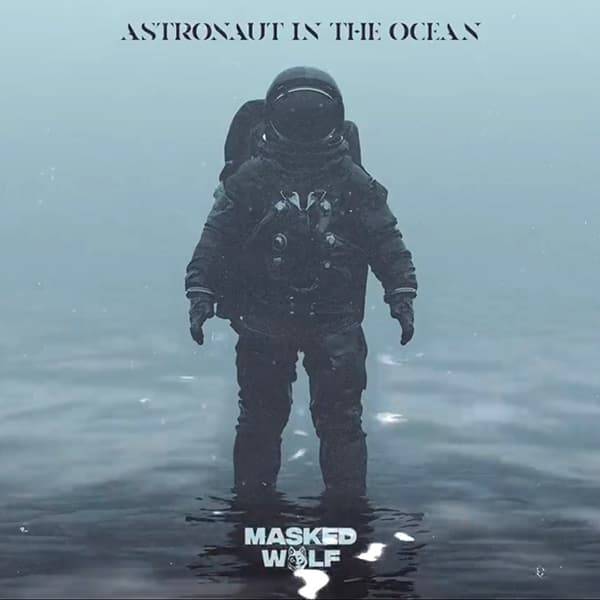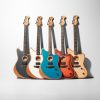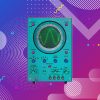
Astronaut in the Ocean, Unmasked
With 380 million streams on Spotify and 165 million views on Youtube, Masked Wolf’s ‘Astronaut in the Ocean’ is clearly a global success. Collaborator and producer Tyron Hapi talks about making beats, playing out of tune, moving from EDM to hip-hop, and keeping it short to get more streams.

Artist: Masked Wolf
Album: Astronaut in the Ocean
Until recently, Australian hip-hop was an underground movement that barely registered outside of the country. The international success in 2020 of The Kid Laroi (featured in Audio Technology Issue 70) was seen as a global breakthrough that finally put the genre on the world map. Hot on the heels of The Kid Laroi, there’s another Australian hip-hop success story with global impact. ‘Astronaut in the Ocean’ by Sydney rapper Masked Wolf was released in June 2019 on Teamwrk Records, got traction on TikTok, became a sleeper hit, and reached 32 million streams on Spotify by the end of 2020.
LIFT OFF
In January 2021 the song was re-released on Elektra and has since gone viral with 380 million streams on Spotify, 165 million YouTube views, and a Top 5 presence in dozens of countries. The song’s success can, in part, be explained by the fact that, at only 2’ 12” duration, ‘Astronaut in the Ocean’ is a meme song in a similar way as Lil Nas X’s ‘Old Town Road’ – the first entirely TikTok-driven song.
Musically, ‘Astronaut in the Ocean’ is trap with 808s, hi-hats, and echoes of Drake, but it also has a rock feel due to the heavy beat and some filmic electric guitars. The track was made by Melbourne producer Tyron Hapi, who took a break from work on the album he’s currently making with Masked Wolf to discuss how ‘Astronaut in the Ocean’ reached escape velocity. The success of the song naturally makes him feel on top of the world. “I’m stoked. It’s been a very exciting six months. When the song first came out it did OK for a rapper who didn’t have much of a following, but it wasn’t that great. Then it blew up out of nowhere, and now it’s sitting at a point that we’re very happy with. It’s awesome!”
‘Astronaut in the Ocean’ is not Hapi’s first experience of the big time. His song ‘Anyway’, released under his name in 2017 and featuring Mimoza, went platinum in Australia, while ‘About You’, featuring Laurell, went gold last year. Hapi was only 17 when he had his first chart success, but he’d been working hard on his skills as a beatmaker and producer for several years before then. “I’ve been around music my whole life,” he remembers. “My dad is a bassist and a guitarist. I grew up listening to Dire Straits, The Eagles, Fleetwood Mac, all that kind of stuff, and then I listened to rap and so on. I started playing drums at a young age. I went to a music school but dropped out when I was 14. I packed up my drum kit, turned my room into a studio, and got into producing electronic music. I got totally addicted to making something in the studio that sounds awesome to me and that other people enjoy as well.”
Until his current work with Masked Wolf, which is entirely focused on the rapper’s album, Hapi’s beats have always come into being by messing around in his studio, creating whatever he feels like at the moment. The tracks then find a particular purpose later on. ‘Astronaut in the Ocean’ came into being that way, and is, says Hapi, “the quickest and easiest beat I ever made; it took me probably one and a half hours.”
ROCKET SCIENCE
Before elaborating on how he made the beat, Hapi set the scene by describing the environment he made it in. “The core of my system is a 2018 Macbook Pro with 15-inch screen, Intel Core i9 2.9GHz, and 32GB of RAM. I run Ableton on it now, but when I made ‘Astronaut’ I was still on FL Studio. I have a Rode NT1 mic, a UAD Arrow Thunderbolt 3 interface, Yamaha HS10 monitors, and Audeze LCD headphones – which are probably the best on the market for recording. The Arrow allows me to produce while I travel — I like to keep my gear simple and portable.”
“My MIDI keyboard is an M-Audio Oxygen 49, and I have a Fender Strat electric guitar. The main instrument in my studio is a Novation Summit analogue synth. I wasn’t using analogue gear until I got into hip-hop. I made EDM for years, and in that genre everything needs to be perfect. It’s very on the grid, and perfectly EQd and compressed. That’s what makes it dance music.
“Hip-hop beats, on the other hand, need to sound more organic. Using analogue gear helps with that. It adds more warmth. There’s a huge difference between a sine wave from a soft synth like Serum, and a sine wave from an analogue synth where you get flutter and hiss and so on. I love all the sounds that come with the Novation and I like being hands-on with hardware as well.
“For the same reason, I prefer to create my own samples. When you use loops you have to be careful that someone is not going to ask you for a cut. So I stay away from loops done by others. I also use sample packs very sparingly, because if you have access to them then so do millions of other producers. There’s nothing wrong with that, but I prefer to make something no-one has ever heard before. If I do use a sample, and I use Native Instruments’ Kontakt a lot, I try to flip it in such a way that no-one will recognise it. For example, there’s a Masked Wolf track called ‘Star’ for which I grabbed a guitar loop, pitched it down, and added some effects to it. It sounded great, and different, so I used it. On ‘Anyway’ that’s my dad playing the guitar; I had the chords and asked him to play them on an acoustic guitar. Initially he strummed them, but it sounded weird. I then asked him to play the chords as arpeggios and that sounded great. I recorded him with my iPhone; that’s what’s in the track.”
Hapi followed a similar procedure when he made the beat that became ‘Astronaut in the Ocean’, but he played the two guitar parts himself. “The whole project is really simple, just 10 tracks. As I said before, it was the quickest and easiest beat I’ve ever made. Often the best things you do take the least amount of time. There are tracks that you spend hours on and do tons of crazy sound design for, and then they come out and they go nowhere.
“When I started the ‘Astronaut’ beat I had a three-note bass riff. I added a piano, playing the same three notes, and pitched that down an octave. It sounded cool but it it still wasn’t anything crazy, so I thought of also playing the same three notes on the guitar. I’m not a guitar player, but when you’re a beatmaker chopping and quantising things are your best friends!
“I had not tuned the guitar, I just wanted to get the idea down quickly, to see if it made the beat sound cool. I reckoned that if it worked, I could always go back and replay the guitar. So I carried on and produced the rest of the song, adding kick, hi-hats, a clap, a synth and another guitar. When the beat was nearly finished I went back and replaced the original guitar, playing exactly the same part but in tune. However, when I listened to it I thought, ‘this doesn’t sound at all as good as the slightly out-of-tune guitar; it just sounds too perfect, too clean.’ The out-of-tune guitar had a grunge quality to it, an uneasy feeling that really added depth to the track. It made it sound dark and more like a rock song.”
If you have two minutes of a really dope song, everyone will go, ‘oh, it ended already?’ and will play it again.

FL STUDIO VS ABLETON
Hapi explained that ‘Astronaut in the Ocean’ was the last project he did in FL Studio. He switched to Ableton two years ago. “Ableton is just much faster in terms of shortcuts and accessibility. There’s nothing wrong with FL Studio; it’s an incredible DAW but, for example, take something as simple as consolidating an audio clip. In FL Studio you need to click a whole bunch of things to do that, whereas in Ableton you just do Command + J and it’s done. That’s 30 seconds saved. When you’re doing hip-hop you’re resampling audio all the time, so it’s a huge thing to have a shortcut like that.
“Ableton has a different workflow, and, to be honest, I was getting bored with FL Studio and its layout and was beginning to suffer creative writing blocks. Ableton is dope, it’s well-organised, and I can just go in there and be creative. You can get your ideas down as quickly as possible and you can get them sounding good without clicking too many buttons. The stock plugins in Ableton are incredible, and when I open up a project, all tracks – whether MIDI or audio – immediately have EQ, a utility to control the volume, and so on. It’s so easy. With FL Studio I’m not aware of options to load up tracks and immediately have plugins ready, like a template.”
“Having said all that, in my opinion, the piano roll in Ableton as not as good as the one in FL Studio. The FL Studio piano roll is insane and I’ll probably continue to use that. Also, if you create a MIDI clip in FL Studio, you can cut it in half and have two MIDI clips; you can’t do that in Ableton. But Ableton is great for EDM, and it’s great for hip-hop. It’s perhaps not so great when you record bands; you’d want Logic or Pro Tools for that, and also for things like vocal comping [a feature Ableton has recently added — Ed.]”
STEM ANALYSIS
After completing the demo of the beat for ‘Astronaut in the Ocean’, he sent it to Masked Wolf. “Harry came up with his vocal idea while driving in the car on the way home. He had the first line, ‘What you know about rollin’ down in the deep?’ in his head, and he developed the vocals from there. He recorded a demo version at home, sent it to me, and I finished the beat around that hook. Harry then re-recorded the vocal at Studios 301 in Sydney, with Simon Cohen vocal producing – he does many big-name artists. I replaced the vocal files in my session, and after that it was just a matter of tweaking things. There wasn’t really a mix as such, but I may have added more processing to the vocals, or EQd things that got in the way – for example, if the guitar got in the way of the vocal.”
Hapi did all this in FL Studio. However, after he switched to Ableton his computer crashed and he was not able to retrieve the original session to provide screen shots. He did make stems, however, and used those to retrace his steps in creating and finishing ‘Astronaut in the Ocean’. “I think the 808 came from a Cymatics sample pack. The first thing I would’ve done was apply EQ, using a FabFilter Pro-Q3. With anything, but particularly 808s and kicks, I’ll add a brickwall filter at 20Hz that blocks the low frequencies the ear can’t hear. I think I did another cut on the 808s around 50Hz or 60Hz, taking off about 2dB because the 808 was overpowering the kick a little bit. It sounds OK, but I wish I had side-chained the 808 a bit more to the low-end frequencies of the kick. I was new to making hip-hop at that time…
“After that I added some saturation with the Dada Life Sausage Fattener. I needed to add some high-end distortion and harmonics to the 808 because it was just a sine wave, and needs the fuzz to be audible through phone and laptop speakers. On a beat like this you need to be able to hear the 808s through an iPhone speaker!”
I wasn’t using analogue gear until I got into hip-hop.

DRUMS, GUITARS & BRASS
Hapi continued his exposé of ‘Astronaut in the Ocean’ by talking about the drums. “They’re the simplest trap drums in the world; there’s nothing crazy going on with them. A simple kick pattern, a clap, and hi-hats with rolls where needed to keep it interesting. I also had a bongo loop, which I pitched down. I cut out some low end from the bongo loop with the Pro-Q3 and added some reverb, probably with the FabFilter Pro-R.
“I added a bass from the Reveal Sound Spire soft synth, a patch called RememberDeep from the Alonso Thomas Gold soundbank. That bass sounds incredible. It’s very analogue, and thick sounding.
”Incidentally, ‘Astronaut’ starts with a glitch noise that I got from a sample pack, to which I added a stutter effect which I might have done with Cableguys Shaperbox. Then the guitars come in, then the synths, and then the vocal.
“I mentioned the lower guitar earlier, which plays the three-note riff. I used some distortion on it, probably from the Retro Color RC-20, and I think I also used a stock FL Studio EQ. I recall adding some FabFilter Pro-R reverb with a medium setting, just so the guitar didn’t sound entirely dry. The other, higher, guitar is me playing one note and bending it. I lowered its volume whenever Harry’s voice came in because they’re in the same frequency range.
“There’s also a brass loop in the song, which is drowned in reverb from Native Instruments’ Raum – my favourite reverb of all time. I use it on every track I do. The brass is a loop from a Latin sample pack that I cut up pretty heavily; I don’t think anyone will recognise the original sample. I also applied a sweep filter to the brass, probably with The Sweeper from Denise Audio. I use that on pretty much everything that needs to be sweep filtered, for example on hi-hats and cymbals. Throughout the verse, only the low frequencies of the brass loop come through at first, and then it gradually opens up so you hear the high end. That’s a trick from EDM.
“Finally there’s a synthesizer with a pluck sound I made inside Xfer Serum. I layered it with another pluck sound, and when it’s added in behind the guitar it fills up the space a bit. There are also a few riser sweeps, which again are from my EDM days where we always create a sweep coming up to a transition – it builds tension, in this case towards the first vocal line which is “What you know about rollin’ down in the deep?”
“In the first version of the track I had the beat coming in where the vocals come in, but at one point I accidentally deleted a few bars of the drums and it sounded really cool so I left it like that. The drums and bass now come in a few seconds later, on “deep,” and that makes it sound like they hit a lot harder. You expect something to come in, and instead there’s nothing apart from the vocal, and then the beat hits. It’s a very common thing in EDM, where you have a big buildup and the kick and bass come in a few beats or bars later than expected. I recall from my DJ days that crowds love it!”
TWO DOPE MINUTES
Another aspect of ‘Astronaut in the Ocean’ that may have contributed to its enormous success is its length, or rather, at 2’12”, its brevity. “Yeah, in the first version of the track Harry’s verse was very long, but we made a strategic decision to keep it very short. It’s a marketing thing. If you have two minutes of a really dope song, everyone will go, ‘oh, it ended already?’ and will play it again. So instead of one play, you get two. But if you have a three-minute song, people may hit skip after the first or second drop.”
Clearly, the musical content and the various tricks that Hapi employed on ‘Astronaut in the Ocean’ have had the desired effect. With the song still topping the charts around the world, Masked Wolf and he are working hard to capitalise on the attention. “Because ‘Astronaut’ has taken off, Harry and I are currently making an album,” concludes Hapi. “There are some pretty crazy tracks in the works, and not all of them are short! So I’ve dropped EDM and gone full speed ahead with hip-hop. I’m still pretty new at it, but I like to keep the hip-hop that I make unique. Hopefully when the album comes out you’ll hear it and think, ‘There is nothing else that sounds like this.’ That’s the direction we’re heading in!”
380 million people can’t wait to stream it…























A food for thought article on how to do things in a different way. Got a lot out of it.
nice one Mark.
“Astronaut In The Ocean” strangely combines a rather heavy pitch and meaningful message with a maximally rocking, charged beat. The song can be perceived as an ordinary banger – after all, that’s why it got into Tik Tok, or you can listen to the lyrics, and discover a good hidden meaning with surprise.
How do you explain the resemblance to Mozart’s Ozeanraumschiff